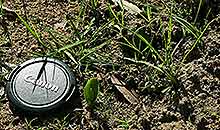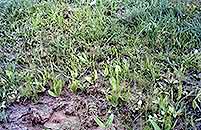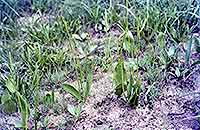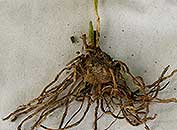Ophioglossum costatum R.Br.
Synonyms |
Ophioglossum fibrosum Schumach. |
|---|---|
Common name |
|
Description |
Rhizome globose, sometimes ellipsoid, up to 15 mm in diameter; roots numerous, descending or radiating, wiry. Leaves up to 4 but mostly 2, held at 60-80° from the horizontal, dull green. Stipe (8-)15-37(-65) mm long, subterranean for most of its length (70-90%), stipe:lamina ratio 0.4-0.7:1, stipe bases not persistent. Sterile lamina dull green, held at 60-80% from the ground, usually flat, sometimes slightly folded, up to 75 × 30 mm, lenght:width ratio 2-3.1:1, lanceolate to narrowly ovate in outline, apex pointed to rounded, base rounded to narrowly wedge-shaped, with an apparent pseudo-midrib formed by elongated meshes of the venation. Fertile segment 5-25 cm long, inserted at or just above the base of the lamina, fertile spike:lamina lenght ratio 2.6-3.2:1. Sporangia up to 60 pairs. |
Notes | Could be confused with O. gomezianum which has bright to yellowish green leaves with no prominent pseudo-midrib on the under surface of the lamina. O. rubellum has dark green leaves that are held at up to 20° from the horizontal or appressed to the ground. |
Derivation | costatum: ribbed, referring to the apparent pseudo-midrib on the sterile lamina. |
Habitat | On seasonally moist, shallow soils, on sand overlying rocks, at the edge of pans in open to slightly shaded positions; also in alluvial soils along the margins of drainage lines or seasonally moist depressions in dry, deciduous woodland. |
Distribution worldwide | Africa, Madagascar, India and Australia. |
Distribution in Africa |
Angola, Benin, Botswana, Burkina Fasso, Burundi, Cameroon, Central African Republic, Chad, Dem. Republic of Congo, Ethiopia, Ghana, Guinea, Guinea Bissau, Ivory Coast, Kenya, Liberia, Malawi, Mali, Mozambique, Namibia, Nigeria, Rwanda, Senegal, Sierra Leone, South Africa, Sudan and South Sudan, Tanzania , Zambia, Zimbabwe. |
Growth form |
Terrestrial. |
Literature |
|




